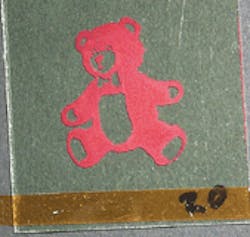ORGANIC LIGHT EMITTERS: Screen printing yields thin films
Researchers at the Optical Sciences Center of the University of Arizona (Tucson, AZ) have demonstrated the use of screen printing as a tool to deposit thin films needed for the fabrication of organic light-emitting devices (OLEDs), according to Ghassan E. Jabbour, who worked with Dino Pardo on the project, supervised by Nasser Peyghambarian. Screen printing is a versatile, simple, fast, and cost-effective coating technique, Jabbour said. "It does not require expensive vacuum technology, as is the case with physical vapor deposition, and can be applied to any surface shape and size, such as windshields, eyeglasses, or inner surfaces, unlike spin coating or inkjet printing," he said. "In addition, unlike spin coating, screen printing is readily applicable to volume production methods such as reel-to-reel printing."
Using screen printing, the University of Arizona group was able to fabricate hole-transport layers from a blend of polycarbonate and triphenyldiamine (TPD) with thickness of 80-90 nm. The OLEDs with such screen-printed layers had an acceptable performance when compared to devices having hole-transport layers based on the same blend, but spun-coated instead, Jabbour said. In fact, similar external quantum efficiency was obtained in both cases.
The screen-printing technique was also extended to print polymer light-emitting logos made from MEH-PPV, a polymer widely used in OLEDs (see image). The photoluminescent image was printed using a nylon monofilament stencil fabric that was properly adjusted to its maximum tensile strength before plastic deformation occurred. The stencil, made up of the nonimage and image area, was fabricated using photographic techniques. In this case, the MEH-PPV polymer was dissolved in an organic solvent, for which the solvent-to-polymer ratio was adjusted to obtain the proper viscosity needed to achieve acceptable image transfer during the printing process.
Screen printing is not a new technique, as evidenced by images printed on the Great Wall of China. It was also practiced as a printing technique in ancient Egypt. The basic elements are the frame, fabric (silk was used in the past), stencil, ink, substrate, and squeegee. The quality of the printed image depends greatly on a careful choice of these elements. Images with extremely good resolution are possible with screen-printing.
Although they were successful in printing OLED materials, the researchers caution that more work is needed regarding application of the screen-printing process in OLED (small molecule- or polymer-based) fabrication. For example, devices with one or more active layers fabricated by screen printing need to be tested for long-term stability.
Nevertheless, with its simplicity, low cost, versatility, and applicability to almost any sort of surface, the screen-printing technique will introduce new dimensions in the fabrication of small molecule- and polymer-based OLEDs. Based on the early development in polymer OLEDs (using PPV as the active layer as demonstrated by Cambridge researchers in 1990) that resulted in device quantum efficiency of 0.01%, the current results from screen printing are very encouraging, Jabbour said.
About the Author
Hassaun A. Jones-Bey
Senior Editor and Freelance Writer
Hassaun A. Jones-Bey was a senior editor and then freelance writer for Laser Focus World.
